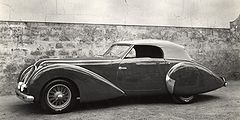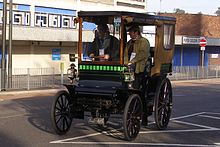- Delahaye
-
Industry Manufacturing Founded 1895 Founder(s) Emile Delahaye Defunct 1954 Headquarters Tours (France) Products Cars Delahaye automobile manufacturing company was started by Emile Delahaye in 1894, in Tours, France. His first cars were belt-driven, with single or twin cylinder engines. In 1900, Delahaye left the company.
Contents
History
In 1901, the Société des Automobiles Delahaye constructed a factory in Paris, where they continued to manufacture cars and trucks. In 1908, they began producing four cylinder engines, in sizes of 1.5 and 2.1 litres, as well as a 2.6-litre V6. They also licensed their designs to manufacturers in the U.S. and Germany. By the end of World War I, their major income was from their truck business.
In 1934, they introduced the 134N, a 12cv car with a 2.15-litre four cylinder engine, and the 18cv 138, powered by a 3.2-litre six — both engines derived from their successful truck engines. In 1935, the introduction of the sporting Model 135 "Coupe des Alpes" car brought success to their car business as well, while the truck business also continued to thrive. Some of the great coachbuilders who provided bodies for Delahayes include Figoni et Falaschi, Chapron, and Letourneur et Marchand.
As was customary for car manufacturers in this period, Delahaye also tried its hand in racing in the middle of the 1930s after the American heiress Lucy O'Reilly Schell approached the company with an offer to pay the development costs to build cars to her specifications for rally racing. In 1937, René Le Bègue and Julio Quinlin won the Monte Carlo Rally driving a Delahaye. This was the time when the German Nazi party, in an attempt to establish dominance for their party, nation, and philosophy, nationalized the Mercedes-Benz and Auto Union racing teams, pouring money in to glorify Germany. Against this juggernaut, Delahaye brought out the Model 145, the so-called "Million Franc Delahaye" after its victory in the Million Franc Race; it was driven by René Dreyfus to victory at Pau in 1938, doubly humiliating the Nazis since a Jewish driver in a French car beat their vaunted, state of the art, Mercedes-Benz Silver Arrows. This competition victory combined with French patriotism to create a wave of demand for Delahaye cars, up until the German occupation of France during World War II.
In early 1940, over 100 cars of the 134N, 175, and 168 (Renault-bodied) types were built for the French government. Private sales effectively ceased around June, but small numbers of cars continued to be built for the occupying forces until at least 1942.
After the Second World War
After World War II, in late 1945, production of the 135 was resumed, and the 4.5-litre model 175 was introduced in 1948. This model was followed by the Type 235 in 1951, with an uprated 135 engine and styling by Philippe Charbonneaux.[1] After the war the depressed French economy and an increasingly punitive tax regime aimed at motoring in general and at cars with engines above 2-litres in particular made life difficult for luxury auto-makers. Like all the principal French automakers, Delahaye complied with government requirements in allocating the majority of its vehicles for export, and in 1947 88% of Delahaye production was exported (compared to 87% of Peugeot and 80% of Talbot output), primarily to French colonies. Nevertheless, Delahaye volumes, with 573 cars produced in 1948 (against 34,164 by the market leader, Citroen), were unsustainably low.[2]
Until the early 1950s a continuing demand for military vehicles enabled the company to operate at volumes, primarily thanks to demand for the Delehaye Type 163 trucks, sufficient to keep the business afloat.[3]
A 1-ton capacity light truck sharing its 3.5-litre engine with the company's luxury cars (albeit with lower compression ratios and power output) made its debut at the 1949 Paris Motor Show.[3] During the next twelve months this vehicle, the Delahaye 171, spawned several "break" bodied versions resembling very large station wagons, the most interesting of which were the ambulance and 9-seater familiale variant, this latter being a precursor to the mpvs that appeared, initially from Renault and Chrysler, in the 1980s. The vehicle's large wheels and high ground clearance suggested that it was targeted on markets where many roads were constructed largely of dust and mud, and the 171 was, like the contemporary Renault Colorale which it in some respects resembled, intended for use in France's African colonies. The vehicle also enjoyed some export success in Brazil, and by 1952 the Delahaye 171 was being produced at the rate of approximately 30 per month.
As passenger car sales slowed further the last new model, a 2.0-litre Jeep-like vehicle known as VLRD, sometimes known as the VLR (Véhicule Léger de Reconnaissance (Delahaye)), was released in 1951.[3] The French army believed that this vehicle offered a number of advantages over the "traditional" American built Jeep of the period. During 1953 the company shipped 1,847 VRDs as well as 537 "special" military vehicles: the number of Delahaye or Delage badged passenger cars registered in the same year was in that context near negligible at 36.
In 1954, Delahaye was taken over by Hotchkiss, who shut down car production and, after producing trucks with the Hotchkiss-Delahaye nameplate for a few more months, dropped the Delahaye name altogether.
Models
- Delahaye 134 - 1933-40
- Delahaye 135 - 1935-54
- Delahaye 138
- Delahaye 148
- Delahaye 168 - 1938-40
- Delahaye 175 - 1948-51
- Delahaye 178
- Delahaye 180
- Delahaye 235 - 1951-54
References in culture
A Delahaye 175S Roadster was sold at auction in August 2010 for $3 Million. The car was originally given as a gift to the British actress Diana Dors.[4]
Picture gallery
References
- ^ "Famous on Road and Race Track". The World of Automobiles. 5. Columbia House. 1974. p. 524.
- ^ "Automobilia". Toutes les voitures françaises 1948 (salon Paris oct 1947) (Paris: Histoire & collections) Nr. 7: Page 26. 1998.
- ^ a b c "Automobilia". Toutes les voitures françaises 1953 (salon Paris oct 1952) (Paris: Histoire & collections) Nr. 19: Page 23. 2000.
- ^ "Diana Dors sports car fetches $3m at auction". BBC Website (www.bbc.co.uk). 2010-08-15. http://www.bbc.co.uk/news/world-us-canada-10975531. Retrieved 2010-08-16.
External links
Categories:- Car manufacturers of France
- Companies established in 1894
- Companies disestablished in 1954
- Defunct motor vehicle manufacturers of France
- French racecar constructors
- Delahaye vehicles
Wikimedia Foundation. 2010.















